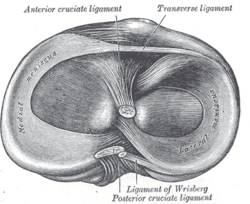Meniscus (anatomy)
| Meniscus | |
|---|---|
 Head of right tibia seen from above, showing menisci and attachments of ligaments | |
 Left knee-joint from behind, showing interior ligaments | |
| Details | |
| Identifiers | |
| Latin | meniscus |
| Greek | μηνίσκος ("meniskos") |
| MeSH | D000072600 |
| TA98 | A03.0.00.033 |
| TA2 | 1544 |
| Anatomical terminology | |
A meniscus (pl.: menisci or meniscuses) is a crescent-shaped fibrocartilaginous anatomical structure that, in contrast to an articular disc, only partly divides a joint cavity.[1] In humans, they are present in the knee, wrist, acromioclavicular, sternoclavicular, and temporomandibular joints;[2] in other animals they may be present in other joints.
Generally, the term "meniscus" is used to refer to the
The term "meniscus" is from the Ancient Greek word μηνίσκος (meniskos), meaning "crescent".[3]
Structure
The menisci of the knee are two pads of
Menisci show low-intensity on MRI images.[5]
Function
The menisci act to disperse the weight of the body and reduce friction during movement. Since the condyles of the femur and tibia meet at one point (which changes during
Clinical significance
Injury

In sports and orthopedics, people sometimes speak of "torn cartilage" and will actually be referring to an injury to one of the menisci. There are two general types of meniscus injuries: acute tears which are often the result of trauma or a sports injury and chronic or wear-and-tear type tears. Acute tears have many different shapes (vertical, horizontal, radial, oblique, complex) and sizes. They are often treated with surgical repair depending upon the patient's age as they rarely heal on their own. Chronic tears are treated symptomatically: physical therapy with or without the addition of injections and anti-inflammatory medications. If the tear causes continued pain, swelling, or knee dysfunction, then the tear can be removed or repaired surgically. The unhappy triad is a set of commonly co-occurring knee injuries which includes injury to the medial meniscus.
Conservative management
Surgical treatment
Two surgeries of the meniscus are most common. Depending on the type and location of the tear, the patient's age, and physician's preference, injured menisci are usually either repaired or removed, in part or completely (meniscectomy). Each has its advantages and disadvantages. Many studies show the meniscus serves a purpose and therefore doctors will attempt to repair it when possible. However, the meniscus has poor blood supply, and, therefore, healing can be difficult. Traditionally it was thought that if there is no chance of healing, then it is best to remove the damaged and non-functional meniscus, although at least one study has shown that there is little significance if a meniscectomy is done for a degenerative tear.[7] However, resuming high-intensity activities may be impossible without surgery as the tear may flap around, causing the knee to lock.
A 2017 clinical practice guideline strongly recommends against surgery in nearly all patients with degenerative knee disease.[8]
Etymology
The term meniscus derives from Greek μηνίσκος meniskos, meaning "crescent". The word was used for curved things in general, such as a necklace or a line of battle.[3]
Gallery
See also
- Meniscal cartilage replacement therapy
- Discoid meniscus
- Anterior cruciate ligament
- Meniscus transplant
References
- Sources
- "Meniscus". Stedman's Medical Dictionary, 27th edition. eMedicine - Lippincott Williams & Wilkins. 2003. Archived from the original on February 21, 2008. Retrieved 2008-02-20.
- Cluett, Jonathan (February 10, 2008). "Meniscus Tear — Torn Cartilage". About.com. Archived from the original on March 2, 2008. Retrieved 2008-02-20.
- Diab, Mohammad (1999). Lexicon of Orthopaedic Etymology. Taylor & Francis. ISBN 90-5702-597-3.
- Gray, Henry (1918). "7b. The Knee-joint". Gray's Anatomy of the Human Body. Archived from the original on January 23, 2008. Retrieved 2008-02-20.[full citation needed]
- Platzer, Werner (2004). Color Atlas of Human Anatomy, Vol. 1: Locomotor System (5th ed.). ISBN 3-13-533305-1.


